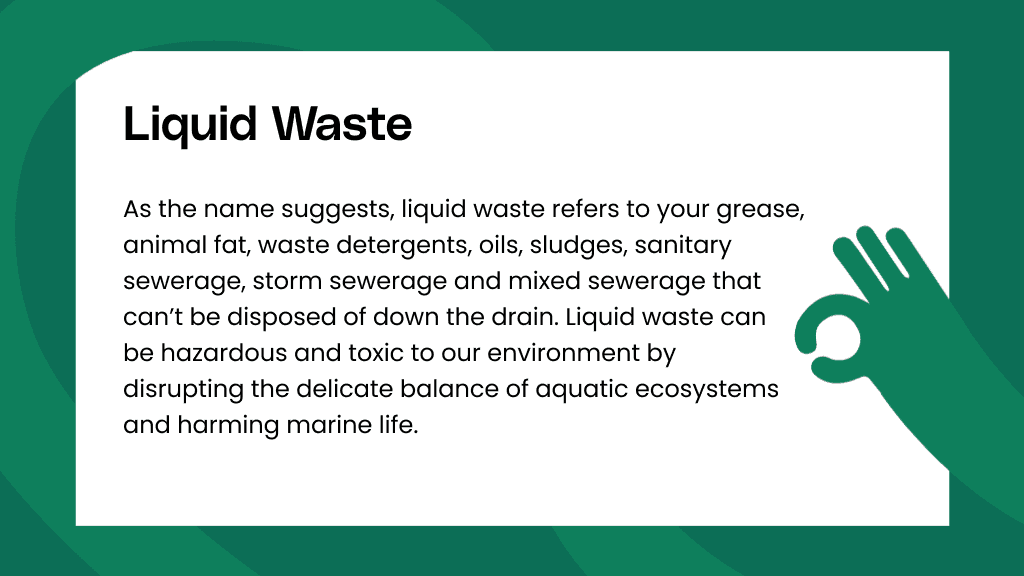Reclaim Waste Can Be Fun For Anyone
Reclaim Waste Can Be Fun For Anyone
Blog Article
7 Simple Techniques For Reclaim Waste
Table of ContentsThe Best Guide To Reclaim WasteThe Ultimate Guide To Reclaim WasteAbout Reclaim WasteThe Ultimate Guide To Reclaim WasteGet This Report on Reclaim WasteA Biased View of Reclaim Waste

Never put hazardous compounds down sinks, commodes or stormwater drains pipes Substances consisting of fuel, grease, oil, chemicals and herbicides, and solvents such as paint strippers should not be put down sinks, toilets or stormwater drains pipes. These materials are tough to eliminate in the sewage treatment procedure and cause pollution problems in our local rivers.

Although fluid waste is a term that covers a broad selection of materials, there's a great factor why leaving its disposal to the experts is recommended. Liquid waste is non-solid product that has no additional usage and has to be dealt with and disposed of according to regional, state and government regulations.
The Reclaim Waste Ideas
Instances of fluid waste can include wastewater, fats, oils or oil, utilized oil, liquids, solids, gases or sludges and unsafe household fluids, there are some that are taken into consideration to be more hazardous than others when it comes to the setting and the wellness of pets and humans alike. It's therefore that each state and area have stringent regulations connected to fluid waste management.
Fluid waste can be stored in holding tanks or packaged in drums, intermediate mass containers or approved tiny containers prior to either being treated or removed using outsourced vacuum cleaner trucks. Given the nature of the materials, liquid waste can not go in the basic waste stream and there are strict laws on exactly how to dispose of it appropriately.
(https://www.openstreetmap.org/user/reclaimwaste1)Depending upon a resolution of the degree of risk, it might be needed to remediate those sites. Additionally, dangerous liquid chemical wastes are regulated waste and must be tracked based on the state waste regulations. Under the chain of guardianship and obligations, owners are liable and accountable for waste produced by a business.
One of the core applications for superabsorbent polymers (SAPs) is liquid waste solidification. liquid waste disposal melbourne. SAPs are used by waste administration professionals to stop potentially dangerous liquids from getting in rivers, groundwater aquifers, and various other delicate environments. Because liquids can rapidly carry pollutants into ecological receptors and possibly add to geotechnical failures, liquid wastes are generally restricted from disposal in land fills
Reclaim Waste Things To Know Before You Get This
Basically, totally free fluids are liquids that separate from the solid section of index waste product. Fluid waste can consist of the following: HDD mud and cuttings Landfill leachate Wastewater treatment sludge & biosolids Dug up sediments Oil and gas drill cuttings Working out pond filth Hydro Excavation slurry Coal combustion residuals/ash Storage tank base sludge Concrete grinding/polishing slurry Associated Post: For a sensible instance of totally free fluids separating from waste material, take into consideration the complying with situation: A waste monitoring specialist tons a dump associate sludge from a wastewater treatment plant's aeration container, throughout a routine upkeep event.
When the driver shows up at the land fill, he notices water leaching from the sludge and pouring from the dump truck. The tons was declined by the landfill and the driver was forced to dispose of the waste as a liquid waste at an unique center, which raised the disposal costs tremendously.
We likewise need to be accountable for the appropriate disposal of our waste products. It is not sufficient that we pay waste disposal firms to take treatment of our rubbish.
Reclaim Waste for Beginners

Segregating your waste can begin inside the home. Segregate dry and fluid waste as well as edible waste, biodegradable and non-biodegradable materials.
Layer the bottom with soil to absorb the wet waste. Layer the garden compost with wet and completely dry waste as well as dirt to keep a balance in between the wet and the completely dry.
Reclaim Waste for Dummies
To facilitate faster disintegration, you can likewise include semi composted dirt to the compost. If you observe the scent is ending up being too solid, include added papers and paper waste or add even more holes to the compost bin to keep the equilibrium of the waste materials.
We likewise need to be responsible for the appropriate disposal of our waste materials. It is not enough that we pay waste disposal companies to take care of our rubbish.
Our waste, our duty. Have you ever before questioned what happens to your fluid waste after it's accumulated? Did you recognize that liquid waste can be recycled?
The Best Strategy To Use For Reclaim Waste
Segregating your waste can start inside the home. Set apart completely dry and fluid waste as well as edible waste, naturally degradable and non-biodegradable products.
You can make use of old trash container, pail, yard pot or old plastic drums. Drill 4 to five openings in the container so the air can flow. Layer all-time low with soil to absorb the damp waste. Start the composting procedure. Layer the compost with damp and dry waste in addition to soil to keep a balance between the wet and the completely dry.
To promote faster disintegration, you can additionally include semi composted dirt to the compost. If you notice the scent is coming to be as well solid, include extra papers and paper waste or include even more holes to the garden compost container to keep the balance of the waste materials.
Report this page